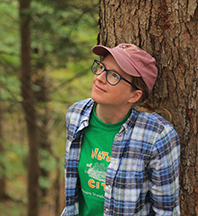Week of June 30, 2024 – July 6, 2024
by Anna Stunkel, Environmental Educator
Throughout this past spring, Syracuse third graders had the special opportunity to explore the waters of Furnace Brook in Elmwood Park as part of the Baltimore Woods Nature in the City program. This field trip is one of my favorite things that we do each spring, in large part because it’s wonderful to see the joy that students experience.
We start the trip by discussing what we can learn from catching stream critters. Swimming scuds and crawling caddisflies are not only fun to find, but they help us to learn about the brook’s water quality. If we find a lot of species that are sensitive to pollution, that would suggest that the water is clean and healthy. If most of the species that we find are tolerant of pollution with less diversity, then the opposite would be true. I explain the scoring system to the students, with 22 being considered a very high number of points. We look at our surroundings and ponder why the stream might be healthy or unhealthy in this area. How much trash do we see? Is the water stagnant or quickly flowing and oxygenated? Are there tree roots above us that cradle the hill’s soil, reducing erosion and catching things that we don’t want in our water?
Once we go over some guidelines to keep ourselves and the creatures safe, it’s time to sample! The students often start off a little hesitant, with questions like, “will the water be cold?” or even, “are there alligators in there?!” As they cautiously dip their toes into the water, gradually they gain confidence and begin to catch more and more creatures. “Wow, what are these?” they call excitedly, carrying over big rocks crawling with mayflies and nets teeming with scuds. Their uncertainty transforms into delight as they tromp through the water, surprised with every scoop of their nets or overturned rock. We often sample for quite a long time, but the time flies and it seems like the students could just keep going.
We end the sampling session by gathering up to tally our species score, taking a closer look at some of our findings and their adaptations in bug jars. Once we return to join the other classes, everyone excitedly shares their scores and a few creatures that the groups found.
These field trips encourage third graders to think as caring scientists and stewards of a clean watershed, while also bringing them a spark of joy and discovery as they explore the stream. We look forward to seeing them next year in fourth grade!


